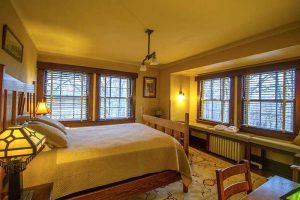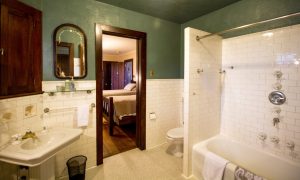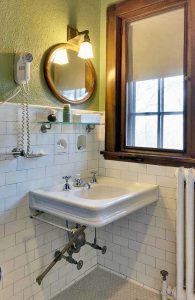Small Home Gazette, Winter 2018
Letter From the Editor: a house with its features intact
When you love vintage houses, you’re bound to experience disappointment. Virtually all of them have been “improved” in ways that, with the passing of time, turn out to be mistakes. Some mistakes we’ve inflicted on our own homes—I certainly have.
Over time, houses become Frankenstein’s monsters. We’ve all seen (or lived in) bungalows with a crudely grafted-on 1960s plastic-tiled bathroom; a badly transplanted 1970s kitchen; or a brick fireplace slathered with white paint.
 In fact, it’s increasingly rare to find a house with all its features intact. That’s why it was gratifying to spend time recently at Four Mounds estate. Located on 54 wooded acres on the banks of the Mississippi River just outside Dubuque, Iowa, Four Mounds is more than just a bed and breakfast. Its nonprofit foundation supports the community in multiple ways, including teaching marketable skills to at-risk high school kids.
In fact, it’s increasingly rare to find a house with all its features intact. That’s why it was gratifying to spend time recently at Four Mounds estate. Located on 54 wooded acres on the banks of the Mississippi River just outside Dubuque, Iowa, Four Mounds is more than just a bed and breakfast. Its nonprofit foundation supports the community in multiple ways, including teaching marketable skills to at-risk high school kids.
But it’s Four Mounds’ deep commitment to the preservation and maintenance of its historic buildings that inspires me. There are three houses available to rent rooms in—the brooding Grey House, a seven-bedroom Arts & Crafts manor built in 1908; the 1924 White House, a charming colonial revival residence; and the Marvin Gardens Cabin, a cozy, wood-paneled 1953 cottage.
 Though the structures were built decades apart, they share a common thread—all are in virtually original condition, right down to the bathrooms and kitchens. To spend time at Four Mounds is to enter a world immune to passing house design trends and fads. It’s the antidote to HGTV, where everything is perpetually ripped out and updated in frantic, half-hour episodes.
Though the structures were built decades apart, they share a common thread—all are in virtually original condition, right down to the bathrooms and kitchens. To spend time at Four Mounds is to enter a world immune to passing house design trends and fads. It’s the antidote to HGTV, where everything is perpetually ripped out and updated in frantic, half-hour episodes.
The guiding spirit behind Four Mounds is John Gronen, great-grandson of the estate’s original owner. Gronen’s deep respect for the property and refusal to remove the buildings’ original materials is locally legendary. When repairs were needed to 100-year-old bathroom plumbing in the Grey House, he refused to let workers break through the original hex-tile floors and subway-tile wainscots, which would have rendered them irreparable.
 “We had plumbers tell us that we were fighting a losing battle, that we should just get rid of this stuff,” recalls Gronen. “In the end, we found the right people, people who would take the time.” He found a plumber who was willing to do the work from below, surgically reaching up through openings cut in the ceiling of the room beneath each bathroom.
“We had plumbers tell us that we were fighting a losing battle, that we should just get rid of this stuff,” recalls Gronen. “In the end, we found the right people, people who would take the time.” He found a plumber who was willing to do the work from below, surgically reaching up through openings cut in the ceiling of the room beneath each bathroom.
The result of such commitment to preservation is an intact environment that is increasingly rare. To spend time at Four Mounds is to be reminded of why we love old houses and to draw inspiration for the stewardship of our own homes.











